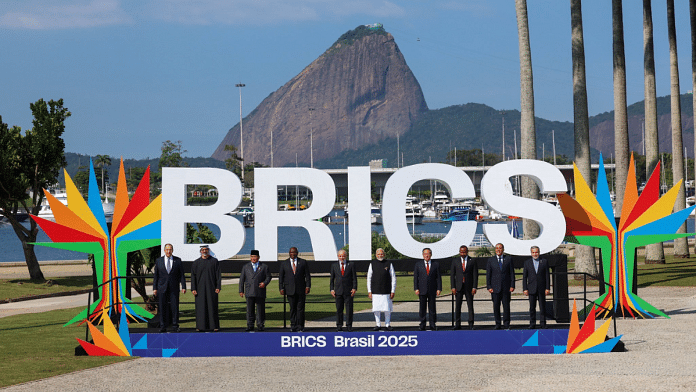Thank you dear subscribers, we are overwhelmed with your response.
Your Turn is a unique section from ThePrint featuring points of view from its subscribers. If you are a subscriber, have a point of view, please send it to us. If not, do subscribe here: https://theprint.in/subscribe/
In 1944, as World War II drew to a close, delegates from 44 nations gathered in Bretton Woods, New Hampshire, to lay the foundation of the post-war financial order. The resulting institutions—the International Monetary Fund (IMF) and the World Bank—came to dominate global development finance. Eighty years on, a new multilateral entity, the New Development Bank (NDB), popularly known as the BRICS Bank, is emerging from the Global South with ambitions to reshape that order.
At its core, the NDB reflects a growing dissatisfaction with the governance structure and policy conditionality’s of Bretton Woods institutions. The United States, for instance, holds 16.5% of IMF voting power, granting it an effective veto on major decisions that require an 85% majority. Meanwhile, India has just 2.63%, Brazil 2.22%, and China 6.08%—a stark mismatch when compared to their combined share in global GDP and trade (IMF Quota Report, 2024). Repeated calls for reform have made little headway, fuelling the drive for alternative platforms.
A Bank Born of Frustration
Launched in 2015 with authorised capital of $100 billion, equally shared by Brazil, Russia, India, China, and South Africa, the NDB was conceived as a response to the perceived inequities of the international financial system. Though modest in size compared to the World Bank’s asset base of over $260 billion (World Bank Annual Report, 2024), the NDB’s influence is growing.
The NDB has approved over $32 billion in loans, largely for infrastructure and clean energy projects in member states. But its significance lies less in its financial heft and more in its structural departures from Bretton Woods: equal voting rights among founding members, loans without intrusive policy conditions, and growing emphasis on local currency lending.
The Push for De-Dollarization
One of the NDB’s most radical departures is its push to lend in local currencies. Following the 2022 Western sanctions on Russia—including the freezing of its central bank reserves—the BRICS countries became increasingly wary of the dollar’s weaponisation. In response, the NDB announced in 2023 that it would aim to conduct 30% of all lending in local currencies like the rupee, real, yuan, and rand.
This shift reflects a broader de-dollarization trend. According to IMF’s COFER data, the U.S. dollar’s share of global forex reserves has declined from over 70% in 2000 to about 58.4% by end-2024. Local currency lending reduces foreign exchange risk and enhances financial autonomy—critical for developing countries navigating volatile global markets.
India’s Strategic Quiet Role
While China is often seen as the dominant player in BRICS, India has played a quiet but pivotal role in shaping the NDB’s inclusive framework. The Bank’s first president, K.V. Kamath, an Indian technocrat, laid the foundation for its operational ethos—streamlined disbursal, non-interventionist policies, and focus on infrastructure over structural adjustment.
India has also been among the largest beneficiaries of NDB financing, securing loans for metro projects, green energy, and health infrastructure. Most recently, the NDB has explored issuing rupee-denominated bonds via GIFT City, aligning with India’s goal of increasing the rupee’s international role (Economic Times, 2024).
However, India’s approach remains pragmatic. It continues to engage with the IMF and World Bank, recognising their relevance, while using the NDB as a tool for parallel reform rather than rupture. This dual-track diplomacy reflects India’s broader foreign policy—non-aligned but assertively multilateral.
Can the BRICS Bank Replace Bretton Woods?
Not yet—and perhaps not at all. The NDB’s credit rating (AA+) lags behind the World Bank’s AAA, limiting access to the lowest-cost capital. Operational scale, staffing, and global presence remain modest. A 2024 report by the Centre for Global Development noted that while the NDB is faster in project approval, it still struggles with procurement complexity and impact evaluation.
Moreover, the bank’s expansion—to include Egypt, Bangladesh, UAE, and Uruguay—risks diluting its original BRICS focus. Governance coordination, divergent interests, and financial constraints could slow momentum.
Yet, its success shouldn’t be judged by size alone. The NDB has already changed the terms of global financial conversation—emphasising fairness, sovereignty, and multipolarity. By offering development finance without Western-style ideological strings, it has forced older institutions to respond, adapt, and self-reflect.
Toward a Plural Financial Order
Rather than a post-Bretton world, what’s emerging is a pluralist global financial system. Countries are no longer bound to a single route for funding. For the Global South, this translates into choice and bargaining power, whether through Bretton Woods institutions, the BRICS Bank, bilateral arrangements, or regional development banks.
India, with its unique position across multiple platforms, is well-placed to shape this plural order. It need not choose between leading the Global South and engaging the Global North—it can do both.
If Bretton Woods was about post-war reconstruction, the NDB is about post-hegemonic correction. It may not overthrow the old order, but it is certainly ensuring that the next one is no longer West-led by default.
These pieces are being published as they have been received – they have not been edited/fact-checked by ThePrint.


